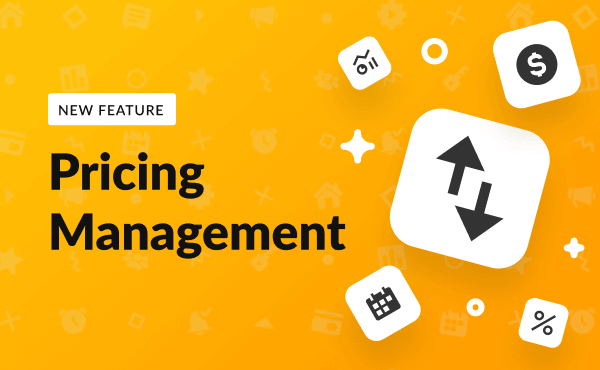The Power of Airbnb Data: How Hosts and Property Managers Can Grow Through Actionable Insights

As an Airbnb host, you have access to a wealth of data that can help you optimize your listing and improve your business. From booking patterns to pricing trends, Airbnb data can provide valuable insights into the preferences of your guests and the overall market.
In this article, we’ll explore some of the most important types of Airbnb data you should be aware of, where you can find it, and how you can use it to your advantage to make your listings more bookable.

Airbnb’s Dominance in the Short-Term Rental Market
As of May 2024, Airbnb boasts a market cap or total dollar valuation of $93.32 billion, positioning it as the 171st most valuable company globally.
With over 7 million listings in more than 220 countries, Airbnb’s impressive growth trajectory reflects its dominance in the world of short-term rental market.
With such a vast network of data, Airbnb hosts can easily fine-tune their rental strategies simply by putting into practice the strategies that seem to working for other hosts, or being able to identify new market trends to capitalize on.
Why is Airbnb Rental Data Analysis Important?
Airbnb data can be used by hosts and property managers to optimize their listing performance, as well as by investors and industry analysts to gain market trends and insights into the broader vacation rental market.
Vacation rental data can be effectively utilized in the following areas:
Optimizing Rental Strategies: Airbnb data helps hosts understand booking patterns, seasonal demand, and pricing trends.
This enables them to set competitive rates and adjust availability to maximize occupancy and revenue.
For example, if a Miami host identifies winter as peak season through booking data and raises rates by 20% during December-February, it could lead to a significant increase in revenue.
Improving Guest Satisfaction: By analyzing guest reviews and feedback, hosts can identify areas for improvement and enhance the guest experience.
If a host finds guests are consistently complaining about their outdated kitchen, they should use this insight to plan an upgrade.
The improved guest satisfaction scores should lead to increases bookings and indirectly boost revenue to offset the overall investment into the property’s new kitchen.
Market Insights: Data from platforms like AirDNA provides insights into market trends, helping hosts and property managers stay competitive.
Understanding local market conditions, such as the average nightly rates and access to popular amenities, allows hosts to make informed decisions about their listings.
Investment Decisions: For investors, Airbnb data can reveal the most profitable markets and properties. This information is vital for making sound investment decisions for more Airbnb homes and maximizing returns.
Forecasting and Planning: Advanced data analytics can predict future booking trends and market changes, allowing hosts to plan ahead and optimize their operations.
How to Find the Most Accurate Short Term Rental Data?
The best way for short-term rentals to collect the most accurate data is to utilize a reliable data tracking and management system. There are a number of both free and paid third-party services that specialize in collecting and analyzing data specifically for the short-term rental industry, such as AirDNA, Beyond Pricing, and Transparent.
They allow you to review data for the vacation rental market at large and compare it to your own so you can make smarter decisions to maximize your cash return. These services use advanced algorithms and machine learning to collect and analyze data on vacation rentals, from various sources, including booking platforms, search and review sites, and social media, in order to provide detailed insights and predictions about rental performance, pricing, and market trends.
In its annual Outlook Report for 2024, AirDNA, for example, outlined the short-term rental (STR) market’s past performance and future expectations:
- Average Daily Rate (ADR) Trends: In 2023, concerns over rising prices led travelers to seek budget-friendly accommodations, resulting in a modest ADR increase of only 0.5%. However, with economic stabilization in 2024, ADRs are expected to grow by 2.1%, reflecting more typical pricing trends.
- Demand and Occupancy: STR demand in the U.S. grew by 15.6% Year-on-Year (YOY) in February 2024, a significant rebound from weak demand in February 2023. Occupancy rates in February exceeded the previous year’s levels, suggesting a return to pre-pandemic norms despite a January slump.
- Key Metrics for the U.S. Short Term Rentals in January 2024:
- RevPAR increased by 0.8% YOY to $173.33.
- Available listings rose by 12.3% YOY to 1.54 million.
- Total demand (nights) grew by 15.6% YOY.
- Occupancy increased by 0.9% YOY to 54.6%.
- ADRs slightly decreased by 0.1% YOY to $317.26.
- Repeat Rent Index (RRI) saw a 3.7% YOY increase.
- Nights booked surged by 18.9% YOY.
In addition to using a third-party data tracking and management system, short-term rental owners and managers can also collect data manually by tracking key performance indicators such as occupancy rates, average daily rates, and guest satisfaction scores on their vacation rentals. This can be done using tools such as spreadsheets or property management software, which can help to streamline data collection and analysis.
Regardless of the approach used, it’s important for short-term rental owners and managers to regularly review and update their data and compare it to historical rental data, to ensure accuracy and relevancy. When you consider that you’re competing against a million hosts for the attention of over a billion guests, the closer you look at the data, the better your vacation rental will ultimately perform.

Essential Airbnb Data Metrics Explained
Let’s take a more in depth look at each of the metrics to help you shape your short term rental strategy.
Booking Data
The most basic type of Airbnb data is booking data. This includes information such as the dates your listing is booked, the length of stay, and the number of guests. This data can help you understand booking patterns, such as which days of the week are most popular, and which times of the year are busiest. You can also use booking data to identify trends in the length of stay and the number of guests, which can help you optimize your pricing strategy and adjust your listing to better accommodate your guests.
One of the most important pieces of booking data to pay attention to is the length of stay. If you find that most of your guests are staying for only one or two nights, you may want to adjust your pricing to attract longer-term guests. Alternatively, if you find that half your guests are staying for longer periods, you may want to consider offering discounts for extended stays.
Another important piece of booking data is the number of guests. If you find that your listing is consistently booked for a certain number of guests, you may want to adjust your pricing and amenities to better suit that demographic. For example, if you notice that your listing is popular with families, you may want to provide additional amenities such as toys and games for children.
Pricing Data
Pricing data is perhaps the most important type of Airbnb data for hosts. This includes information on the prices of other listings in your area, as well as the prices of your own listing over time. By analyzing pricing data, you can determine the optimal price for your listing based on the current market.
One of the most important pricing metrics to pay attention to is the average daily rate (ADR). This is the average price per night that guests are paying for your listing. You can compare your ADR to the average ADR in your area to see if your pricing is competitive. If your ADR is lower than the average in your area, you may want to consider raising your prices. If it’s higher, you may want to lower your prices to attract more guests.
You can also use pricing data to adjust your prices based on the time of year. For example, if you find that your listing is more popular during the summer months, you may want to raise your prices during that time. Similarly, if your listing is less popular during the winter months, you may want to lower your prices to attract more guests.
Reviews Insights
Reviews data is another important type of analysis of Airbnb data for hosts. This includes information on the ratings and reviews that guests leave for your listing. By analyzing reviews data, you can identify areas where your listing is excelling, as well as areas where it may need improvement.
One of the most important review metrics to pay attention to is the overall rating of your listing. This is the average score that guests have given your listing based on factors such as cleanliness, accuracy, and communication. If your property’ overall rating is lower than you’d like, you may want to make improvements to your listing to address any concerns guests have raised.
You can also use review data to identify specific areas where your listing could be improved. For example, if guests consistently mention that your listing is too noisy, you may want to invest in soundproofing. If guests mention that your listing could be cleaner, you may want to hire a cleaning service to ensure that your listing is spotless.
Cancellation Rate Data
Cancellation data is another important type of Airbnb data. Cancellation data can provide valuable insights into the reasons guests may be canceling their bookings, and summary information can help hosts take steps to reduce the number of cancellations they experience. This data includes summary information, such as the number of cancellations, the reason for the cancellation, and the timing of the cancellation.
If you notice that you’re experiencing a high number of cancellations, it may be worth investigating the reasons why. If guests are canceling due to a lack of amenities or poor communication, you may want to make changes to your listing or communication strategy. Alternatively, if guests are canceling due to factors outside of your control, such as weather or transportation issues, you may want to consider offering more flexible cancellation policies.
Occupancy Rate Data
Occupancy data provides insight into how frequently your listing is being booked and can help you make decisions about pricing and availability. This data includes information such as the number of days your listing is booked, the number of days it’s available, and the occupancy rate.
By analyzing historical data of your listings’ occupancy rate, you can identify periods of high demand and adjust your pricing and availability accordingly. For example, if you find that your listing is consistently booked on weekends, you may want to raise your prices for weekend bookings. Similarly, if your listing is frequently available during the week, you may want to lower your prices to attract more weekday bookings.
Market Data
Market data provides a broader perspective on the Airbnb market in your area, and can help you make decisions about pricing, amenities, and marketing strategies. This data includes information such as the average nightly rate in your area, the number of listings in your area, and the types of accommodations and amenities that are popular with guests.
By analyzing market data for similar others, you can identify areas where your listing may be falling short, as well as areas where you may have a competitive advantage. For example, if you notice that most listings in your area offer certain amenities, such as a pool or hot tub, you may want to consider adding those amenities to your listing to remain competitive.
Conclusion
In conclusion, leveraging Airbnb data is crucial for optimizing your vacation rental business. It can provide valuable insights into guest preferences and market trends, helping you make informed decisions about your pricing, availability, and amenities.
To make the most of your your rental data, consider investing in iGMS‘ vacation rental management software, which offers advanced data analytics and automation tools to help you streamline your business operations and maximize your revenue potential.
iGMS‘ vacation rental software is a great tool for hosts to manage their listings and automate the guest communication process, making it easier to provide a high-quality experience to guests. It can help you:
- Synchronize reservations across multiple platforms to eliminate double bookings.
- Automate up to 70% of your daily communication with automated templates and triggered messaging.
- Update your pricing on multiple channels automatically.
- Plan ahead and schedule cleanings much more efficiently.
With the right approach and tools, hosts can unlock the potential of the platform’s Airbnb for Work and increase their earning potential.
About the Author
Danielle Kruger is an SEO Content Writer at iGMS. She is an avid reader and researcher of all things travel, always trying to keep her finger on the pulse of the latest trends and innovations. A self-proclaimed nerd, in her free time Dani enjoys reading, rollerskating, and dabbling in tabletop RPGs.





![Your Monthly iGMS Roundup [February 2020]](/content/images/size/w600/wordpress/2020/02/igms-roundup-feb-2020-cover.png)

